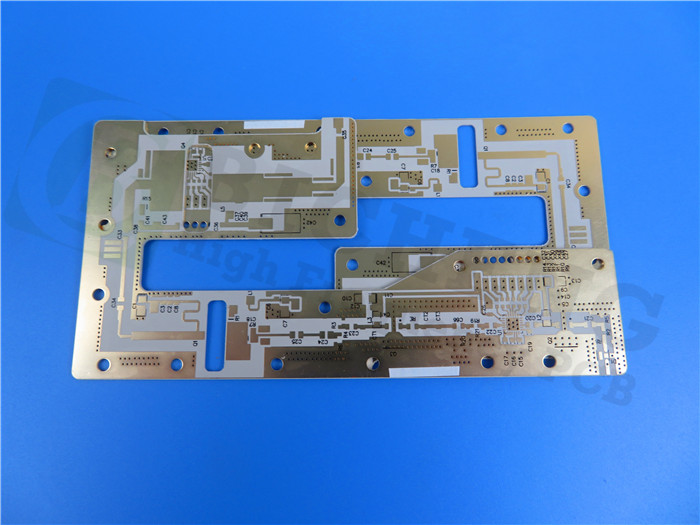What Are Some Other Challenges That PCB Manufacturers Face When Working with High-Frequency PCBs?
In the rapidly evolving world of electronics, the demand for high-performance, high-frequency printed circuit boards (PCBs) is on the rise. These specialized circuit boards are essential components in a wide range of applications, from high-power RF and microwave amplifiers to advanced radar and military electronics. However, the fabrication of high-frequency PCBs poses unique challenges that PCB manufacturers must overcome to ensure reliability and consistent performance.
One such challenge is the use of specialized materials. The Rogers RT/duroid 6035HTC high-frequency circuit material is a prime example of the advanced materials required for these applications. This ceramic-filled PTFE composite offers exceptional thermal conductivity, nearly 2.4 times that of standard RT/duroid 6000 products, enabling improved heat dissipation and lower operating temperatures for high-power circuits. Additionally, the material's low dielectric constant (3.5 ± 0.05 at 10 GHz/23°C) and low dissipation factor (0.0013 at 10 GHz/23°C) contribute to excellent high-frequency performance, with minimal signal distortion and attenuation.

Alongside material selection, PCB manufacturers must also navigate the intricacies of precise impedance control. Maintaining a consistent, controlled impedance across high-frequency signal paths is crucial to prevent reflections and impedance mismatches that can degrade signal integrity. This requires specialized design techniques, such as careful trace width and spacing calculations, as well as advanced manufacturing processes like uniform copper plating and laser trimming.
PCB manufacturers utilize a variety of specialized techniques and processes to ensure the reliability of high-frequency printed circuit boards in harsh operating environments:
Impedance Control
Maintaining precise, consistent impedance along high-speed transmission lines is critical for signal integrity at microwave and millimeter-wave frequencies. Even slight variations in trace width, copper thickness, or dielectric thickness can cause reflection and distortion issues. Specialized impedance control techniques, such as uniform conductor plating and laser trimming, are required.
Crosstalk Mitigation
The close trace spacing and high frequencies involved make high-frequency PCBs highly susceptible to crosstalk between adjacent signals. Design strategies like increased trace spacing, shielding planes, and specialized trace routing are necessary to isolate sensitive RF/microwave traces.
Test and Measurement
Verifying the performance of high-frequency PCBs requires advanced test equipment and measurement techniques. Traditional benchtop multimeters and scopes are insufficient - PCB manufacturers must utilize vector network analyzers, spectrum analyzers, and other specialized instrumentation capable of operating at microwave frequencies.
Thermal Management
Thermal management is another critical consideration. High-power RF and microwave circuits can generate significant heat that must be effectively dissipated to maintain reliability. PCB manufacturers may incorporate features like embedded heat sinks, thermal vias, and forced-air cooling to ensure efficient heat transfer and prevent thermal-related failures.
Miniaturization
Miniaturization is another challenge, as the physical dimensions of PCB features must shrink to maintain appropriate electrical characteristics at higher frequencies. This requires specialized equipment and techniques for fine-pitch routing, micro-vias, and dense component placement.
Reliability Concerns
Reliability is a paramount concern, especially in mission-critical applications like radar, communications, and military electronics. PCB manufacturers must carefully control factors like moisture absorption, thermal cycling, and mechanical stress to prevent premature failures and ensure the long-term durability of these high-frequency circuit boards.
To overcome these challenges, PCB manufacturers must invest in the latest materials, processes, and testing infrastructure. Close collaboration between designers and fabricators is also essential, as they work together to navigate the intricate design and manufacturing requirements of high-frequency PCBs.
As the demand for faster, more capable electronic systems continues to grow, the ability of PCB manufacturers to reliably produce high-frequency circuit boards will be a crucial factor in driving innovation and meeting the evolving needs of the electronics industry. By mastering the technical complexities and investing in the necessary capabilities, PCB manufacturers can position themselves as trusted partners in the development of cutting-edge high-frequency technologies.

 Call Us Now !
Tel : +86 755 27374946
Call Us Now !
Tel : +86 755 27374946
 Order Online Now !
Email : info@bichengpcb.com
Order Online Now !
Email : info@bichengpcb.com














